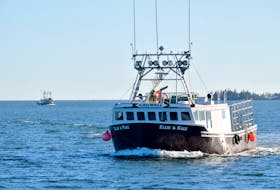"Don't be in a panic about the outdoors," said Andrew Williams, urban forestry coordinator for the Town of Truro. "There are poisonous plants out there but we've been working and playing around them with very few people being harmed. People need to be aware of their surroundings and take proper precautions.
"A few years ago there was a lot of fear mongering and sensationalism about giant hogweed and as far as we know it's never been found in Truro. A lot of people called when they mistook elderberry for giant hogweed."
He said a plant that is commonly found in the area and that people should be cautious around is wild parsnip. It is thought that European settlers brought the plant to North America to grow it for its edible root.
"If you break the plant and get sap on your bare skin, then are exposed to sun, it causes irritation," said Williams. "It's can cause third degree burns. In the eyes it can cause blindness."
The area where he has noticed a large number of wild parsnip plants is at Marshall's corner and along the roadsides and field edges of Highway 311. In some spots only a few plants can be seen but in others hundreds of them turn an area yellow.
Wild parsnip is a member of the carrot/parsley family and spreads quickly, often taking over from native plants. It grows up to 1.5 metres tall and has yellowish-green flowers that grow in clusters. The stem is smooth with few hairs. The plant has been found in all provinces and territories except Nunavut.
Protective clothing and eye protection should be worn when removing wild parsnip. If there are only a few plants, digging them up is recommended. They should not be composted or destroyed through burning but placed in black plastic bags and left in the sun for at least a week. For large infestations it may be best to contact a professional.
Williams said that although the plant poses a danger it has been in Canada for about 400 years with few incidents of serious injury.
"I get discouraged with sensationalism," he added. "We have a lot of toxic plants around. Yew is very toxic. We bring poisonous poinsettias into our homes. It's perspective.
"People need to be responsible and be aware of their surroundings and takes steps for their own safety."
More information on wild parsnip and how to dispose of it safely can be found online at http://www.invadingspecies.com/invaders/plants-terrestrial/wild-parsnip/ .
"Don't be in a panic about the outdoors," said Andrew Williams, urban forestry coordinator for the Town of Truro. "There are poisonous plants out there but we've been working and playing around them with very few people being harmed. People need to be aware of their surroundings and take proper precautions.
"A few years ago there was a lot of fear mongering and sensationalism about giant hogweed and as far as we know it's never been found in Truro. A lot of people called when they mistook elderberry for giant hogweed."
He said a plant that is commonly found in the area and that people should be cautious around is wild parsnip. It is thought that European settlers brought the plant to North America to grow it for its edible root.
"If you break the plant and get sap on your bare skin, then are exposed to sun, it causes irritation," said Williams. "It's can cause third degree burns. In the eyes it can cause blindness."
The area where he has noticed a large number of wild parsnip plants is at Marshall's corner and along the roadsides and field edges of Highway 311. In some spots only a few plants can be seen but in others hundreds of them turn an area yellow.
Wild parsnip is a member of the carrot/parsley family and spreads quickly, often taking over from native plants. It grows up to 1.5 metres tall and has yellowish-green flowers that grow in clusters. The stem is smooth with few hairs. The plant has been found in all provinces and territories except Nunavut.
Protective clothing and eye protection should be worn when removing wild parsnip. If there are only a few plants, digging them up is recommended. They should not be composted or destroyed through burning but placed in black plastic bags and left in the sun for at least a week. For large infestations it may be best to contact a professional.
Williams said that although the plant poses a danger it has been in Canada for about 400 years with few incidents of serious injury.
"I get discouraged with sensationalism," he added. "We have a lot of toxic plants around. Yew is very toxic. We bring poisonous poinsettias into our homes. It's perspective.
"People need to be responsible and be aware of their surroundings and takes steps for their own safety."
More information on wild parsnip and how to dispose of it safely can be found online at http://www.invadingspecies.com/invaders/plants-terrestrial/wild-parsnip/ .








